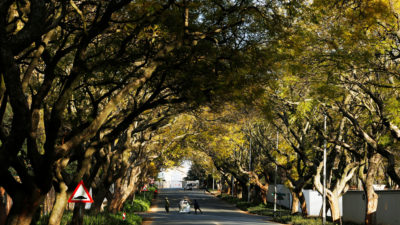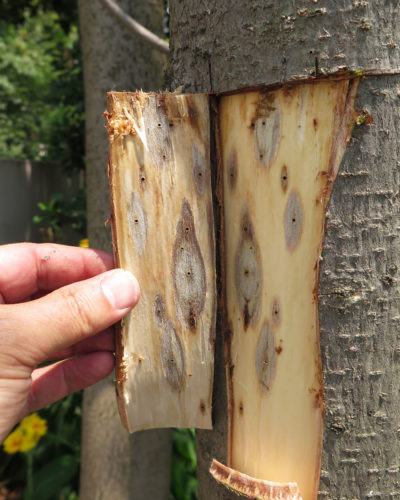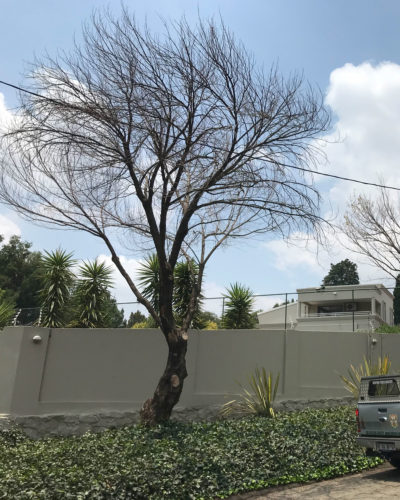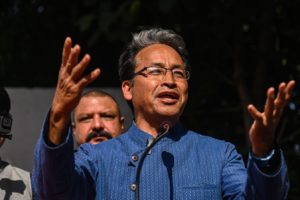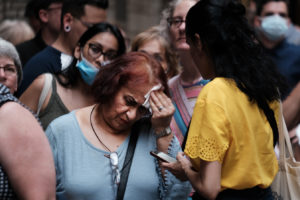“You don’t notice the dead trees until you start looking for them, and then you realize just how many there are,” says Hilton Fryer, a data science consultant. He’s talking about dead trees in Johannesburg, the hustling metropolis that began life in 1886 as a ragtag collection of gold mining camps staked out along the Witwatersrand hill range in the high-altitude grasslands of central South Africa. There weren’t many native trees here — a few found shelter from natural fires in hillside ravines — and once it became clear that area’s gold deposits were the largest ever found anywhere and would deliver up riches for generations, people literally began to put down roots. One by one, they planted trees along the streets, among the houses, and in the parks of the exploding new city, which is still growing.
There are now perhaps 6 to 10 million trees in the Johannesburg region – no one knows for sure. Although a handful of species are locally native, hundreds have been brought in from across the world, including maples, planes, oaks, eucalypts, poplars, wattles, jacarandas, birches, cedars, cypresses, and acacias. Looking north today from the crest of the Witwatersrand, it’s almost impossible to imagine the grassy plains that once stretched out below; a colossal urban forest embedded with thousands of houses is laid out to the horizon.
Fryer’s home is one of these, and last year one of the trees in his extensive yard, a box elder, died. He didn’t think much of it. But then, just before Christmas, he noticed that another tree “was looking bad,” he says. “Around December” — the summer rainy season — “you expect your trees to look lush and green, but my large London plane was looking brown and shitty.”
“That,” he says “was when I became aware of the beetle and started to investigate further.”
The disease caused by the beetles isn’t just a South African problem – it has also invaded Israel and Southern California.
Fryer discovered that the trunks and branches of his trees had been drilled into by the polyphagous shot hole borer, or PSHB, an unusually-adaptable, 2-millimeter-long beetle indigenous to Vietnam. Although tiny, the invasive beetle carries a fungus that grows inside trees, causing a disease called Fusarium dieback. Fryer, who now runs websites aimed at helping fight the plague, reckons that the beetle-fungus combination has already infested well over 100,000 of Johannesburg’s trees and is on track to damage or kill millions more, partially de-greening the city for at least a generation.
The impact of what scientists call the shot hole borer-Fusarium dieback (SHB-FD) complex could extend to air quality and climate. Trees reduce air pollution and can be powerful moderators of the urban heat island effect, caused by asphalt, concrete, and brick absorbing solar energy and radiating it as heat. By killing a large percentage of urban trees, SHB-FD may measurably decrease the health and well-being of the Johannesburg metropolitan area’s 8 million-plus people.
SHB-FD isn’t just a South African problem — it has also invaded Israel and California and is likely present but unidentified elsewhere. It probably got to South Africa in cheap wooden packing materials shipped from Southeast Asia to the east coast port of Durban. In 2012, biologists caught a tiny beetle that they could not identify a few miles from the port, sequenced its genome, and placed its genetic code in an open online database. Often this would match with an already-uploaded code of an insect that had been sequenced and identified previously, but in this case it did not because no other PSHB had ever had its genome sequenced. Its presence thus remained unrecognized by South African scientists until early 2017, when it was found and identified by an entomologist during a routine pest check of the Pietermaritzburg Botanical Gardens, about 50 miles inland from Durban. The PSHB has now been confirmed to have spread to numerous locations across South Africa, some over 800 miles apart and in vastly different climate zones and ecosystems.
The PSHB doesn’t drill into trees to eat them, but to create tunnels within which the Fusarium fungus, its primary food, grows. The fungus can block the transport of water and nutrients to the tree’s leaves, causing branch or whole-tree dieback. Some tree species are reproductive hosts within which the insect makes extensive galleries of tunnels for its eggs and larvae, and these are usually affected the worst, although non-reproductive hosts can also be killed.
Symbiotic relationships between beetles and fungi are quite common — many species engage in it — but what makes the SHB-FD complex unusual is the extraordinary range of tree species it affects. Most ambrosia beetle species (the 3,000-strong group that the PSHB belongs to) drill into dead trees or into only one species or family of living plants. But worldwide the PSHB has been recorded attacking over 300 species of trees from widely diverse families and using over 60 species as reproductive hosts.
“The big danger of this beetle is its adaptability in terms of climate, but also in terms of its host range. It’s just amazing,” says one expert.
“We’ve never [before] seen any of these [ambrosia] beetles going for living trees of such a wide host range” in South Africa, says Wilhelm de Beer of the University of Pretoria’s Forestry and Agricultural Biotechnology Institute. “This is completely — completely — out of the ordinary. There’s absolutely no pattern in what it goes for.” Drilling deep into trees also insulates the PSHB from climatic variances, he adds, “so the big danger of this beetle is both its adaptability in terms of climate, but also in terms of its host range. It’s just amazing.”
Fighting the SHB-FD complex with chemical pesticides is difficult. The insect and fungus both need to be killed deep in the plant tissue, so surface application of a single insecticide is unlikely to work. Various cocktails of pesticides that appear to be effective have been identified, but most of these need to be injected into affected trees several times a year using specialist equipment. Some Johannesburg arborists have been spraying Imidacloprid, one of the neonicotonoids that have been implicated in bee colony collapse disorder and have been banned for outdoor use in the European Union. “Spraying the entire crown of a tree with Imidacloprid,” says Fryer “is going to have too much of a knock-on effect on the environment.”
Polyphagous shot hole borers drill into trees [left] and create tunnels within which the Fusarium fungus grows, blocking the transport of water and nutrients and causing trees such as this Chinese maple in Johannesburg [right] to die. Wilhelm de Beer / FABI
South African law requires pesticides to be registered for particular purposes before commercial use, but so far none of the SHB-FD poisons has been through the process, which can take years (current Johannesburg use by arborists is all “off-label”). The U.S. manufacturers of the best tree-injection systems also don’t distribute in South Africa. Fryer’s now experimenting with homemade injection tools and chemical cocktails on an amateur basis and trying to find ways of spreading what he learns so that trees can be treated within the law. Experts agree the current chemical cocktails are too expensive for widespread use in South Africa, costing hundreds of dollars per tree per year, so that only wealthier residents of Johannesburg may be able to protect individual trees. The cocktails are a temporary solution, say arborists, because trees may be killed by repeated chemical applications and the beetles will likely evolve resistance to the pesticides over time.
Biological control — bringing natural enemies of the PSHB from Southeast Asia to South Africa — could knock back PSHB numbers in the long term. Biologists think that minute parasitic wasps, which are known to attack ambrosia beetles in their native range, could be introduced to South Africa, but these first need to be thoroughly studied to make sure they won’t also attack indigenous South African beetles. These studies could take at least five or 10 years, says de Beer, and there’s no guarantee that a suitable natural enemy will be identified. He’s extremely worried about South Africa’s native trees in natural ecosystems absent such biocontrol, because some have already proved extremely vulnerable to SHB-FD and they will be virtually impossible to protect otherwise.
As the climate warms, trees will be increasingly important in protecting city dwellers against unhealthy or even deadly heat.
Preventing the physical spread of SHB-FD could buy South Africa some time. This shouldn’t be too difficult in theory because the PSHB is a weak flier — it can’t travel much more than a mile, and only when the temperature is warmer than 68 degrees Fahrenheit — and if infested trees are cut down and immediately chipped into tiny fragments, these can be heated or burned to reliably kill SHB-FD. In practice, however, homeowners often hire informal tree-cutters from poorer parts of the city instead of expensive, professional arborists to remove dead and dying trees. The cut wood is a valuable asset and is taken back to poorer neighborhoods, some of which lack electricity, as firewood or sold back into wealthier areas as barbecue fuel. (South Africans are extremely fond of wood-fired barbecues, known as braais.) Thus SHB-FD has been transported back and forth across the Johannesburg metro area and far beyond, and is now threatening tens of thousands of trees planted at government expense to green the poorer, historically black, areas of the city.
A major challenge in protecting urban trees in general is that they fall into institutional cracks. Funding is available from commercial forestry and agriculture to study and combat invasive pests, and conservation authorities deal with pests in national parks and nature reserves. But urban trees are the responsibility of municipalities and private homeowners, neither of which usually have the expertise, institutional capacity, or budgets to protect trees from new, poorly understood threats such as SHB-FD. Simply put, threats like SHB-FD require a sophisticated, fast-moving, coordinated response, which many governments are unable to muster.
As the world urbanizes and the climate warms, trees will be increasingly important in protecting city dwellers against unhealthy or even deadly heat. But, ironically, studies in the United States and Australia are starting to show that some tree pests become more damaging at higher temperatures; trees become more stressed and less able to withstand attack, and pests become more active. Christina Culwick of the Gauteng City-Region Observatory, a research institute based in Johannesburg, notes that the city’s plan to burn SHD-FD-infected trees will cause significant air pollution. And as the SHB-FD outbreaks show, urban trees are also likely to be exposed to an ever-growing array of highly-adaptable insect attackers spread through international trade.
A polyphagous shot hole borer tunnels through the branch of a sycamore tree in Southern California. John Kabashima / UCANR
California has been invaded by the PSHB and another physically identical beetle with almost the same effects known as the Kuroshio shot hole borer. (Because the beetles are practically indistinguishable, researchers often treat them collectively as the “invasive shot hole borer,” or ISHB.) Akif Eskalen, a plant pathologist at the University of California, Riverside has been researching SHB-FD ever since the PSHB was found in a backyard avocado tree in Los Angeles in 2012. Initially, he says, he expected California’s avocado industry to be ruined, because the beetle moved rapidly into avocado trees. As it turns out, SHB-FD only kills some branches of avocado trees, and doesn’t appreciably reduce their fruit yield, he says, but its behavior is very difficult to predict. In 2016, it suddenly moved “like a wildfire” along the Tijuana River valley, knocking back over 100,000 native willow trees and leaving a landscape full of dead wood. In that year, he says, it also attacked native California sycamores, although in 2017 many of the affected trees recovered, only to be severely infested again this year.
A U.S. Forest Service survey estimated that the Los Angeles region could lose 38 percent of its trees to SHB-FD, some 27 million. Eskalen thinks this could come to pass — or a completely different scenario could play out. It’s a new and changing climate for the beetles, with new hosts, he says, and scientists have yet to understand their environmental requirements. “People ask me, ‘What’s gonna happen?’ I tell them, ‘Don’t ask me, even the beetles don’t know what kind of damage they’re going to cause!’”
“This beetle is in California, and it’s going to stay regardless of what we do,” he adds. “We are going to have to learn to live with it, to figure out what we can save and what we cannot.”
Within a few short years, the same will doubtless be said for many areas of South Africa and other parts of the world.
